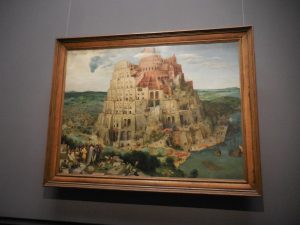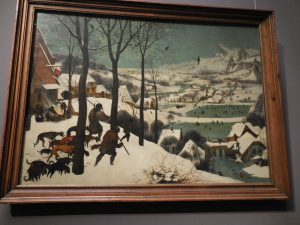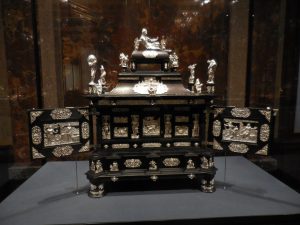The Kunsthistorisches Museum in Vienna
By Tracy A. Burns

Among the leading showcases for art in Europe, Vienna’s Kunsthistorisches Museum boasts a superb Picture Gallery of more than 800 works plus more than 1,000 portraits, the Collection of Sculpture and Decorative Arts (also called the Kunstkammer), the Egyptian and Near East Collection, the Collection of Greek and Roman antiquities, and a Coin Cabinet.
The building itself
Constructed from 1872 to 1891 and founded by Emperor Franz Joseph I, the building is a work of art itself. The monumental staircase is decorated with paintings by Gustav Klimt and portrait medallions of emperors as well as marble and stucco ornamentation. A 60-meter high dome is another impressive sight. The Egyptian and Near East Collection shows off three papyrus-sheaf columns, and the architectural features sport Egyptian motifs.
The Picture Gallery
With works primarily gathered by the Habsburg Emperor Rudolf II and Archduke Leopold Wilhelm, the Picture Gallery features German paintings, Catholic works south of the Netherlands, works from northern Italy as well as Italian and Spanish centers of Baroque painting. Venetian and Flemish works from the 16th and 17th centuries figure prominently in the collection. Paintings were rendered by the masters Titian, Tintoretto, Caravaggio, Albrecht Dürer and Peter Paul Rubens, to name a few. Portraiture is a strength, too, and includes works by Jan van Eyck, Diego Velázquez, Rembrandt Harmensz van Rijn and Sir Anthony van Dyck.
Pieter Brueghel the Elder in the Picture Gallery
 The Picture Gallery is well-known for having the largest group of paintings by Pieter Brueghel the Elder in a museum with 12 of his works on display, including The Hunters in the Snow (1565), The Peasant Wedding (1568-69), The Tower of Babel (1563) and The Fight Between Carnival and Lent (1559). In The Hunters in the Snow notice the attention to detail of the small figures skating on the pond, the pig-slaughtering at the inn and the ice-covered mountains, all rendered in dramatic colors. Peer closely at The Tower of Babel, and take note of the tiny figures of the workmen toiling on the lopsided tower, trying to construct a structure that can never be completed.
The Picture Gallery is well-known for having the largest group of paintings by Pieter Brueghel the Elder in a museum with 12 of his works on display, including The Hunters in the Snow (1565), The Peasant Wedding (1568-69), The Tower of Babel (1563) and The Fight Between Carnival and Lent (1559). In The Hunters in the Snow notice the attention to detail of the small figures skating on the pond, the pig-slaughtering at the inn and the ice-covered mountains, all rendered in dramatic colors. Peer closely at The Tower of Babel, and take note of the tiny figures of the workmen toiling on the lopsided tower, trying to construct a structure that can never be completed.
Kunstkammer
 The Kunstkammer features Habsburg items of art from the late Middle Ages, the Renaissance and Baroque times. It includes the Curiosities Cabinet of Ferdinand II of Tyrol, the Art Cabinet of Emperor Rudolf II, which was first established in Prague, and the Art Cabinet of Archduke Leopold Wilhelm as well as artifacts from the Viennese Treasury. The Late Baroque hall shows off gold pieces, stone-carved items, bronze statuettes and figures, and ivory artifacts. While the Kunstkammer was set up at this museum in 1963, it closed in 2002 for major renovations and only opened again in March 2013.
The Kunstkammer features Habsburg items of art from the late Middle Ages, the Renaissance and Baroque times. It includes the Curiosities Cabinet of Ferdinand II of Tyrol, the Art Cabinet of Emperor Rudolf II, which was first established in Prague, and the Art Cabinet of Archduke Leopold Wilhelm as well as artifacts from the Viennese Treasury. The Late Baroque hall shows off gold pieces, stone-carved items, bronze statuettes and figures, and ivory artifacts. While the Kunstkammer was set up at this museum in 1963, it closed in 2002 for major renovations and only opened again in March 2013.
The other sections of the museum
The Greek and Roman antiquities range from Bronze Age Cypriot pottery of the third millennium BC to the Middle Ages of the 13th century. The Egyptian section features treasures such as the “Hamadryas Baboon” (18th dynasty), “Lion Devouring a Bull” (30th dynasty, 4 BC), mummy-shaped coffins and sarcophagi. The Coin Cabinet houses medals, paper money, commodity money, die marks, stamps, seals, seal stamps, coin scales, and weights as well as coins. The techniques of minting are also featured. Three rooms display about 2,000 numismatic items.




